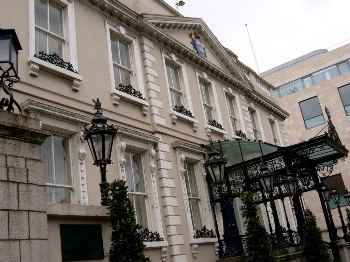Term length 1 year | ||
 | ||
Inaugural holder Richard Muton (Mayor)Sir Daniel Bellingham (Lord Mayor) Formation 1229 (as Mayor of Dublin)1665 (as Lord Mayor of Dublin) | ||
The Lord Mayor of Dublin (Irish: Ardmhéara Bhaile Átha Cliath) is the honorific title of the chairman (Irish: Cathaoirleach, [ˈkahiːɾˠlʲəx]) of Dublin City Council which is the local government body for the city of Dublin, the capital of Ireland. The incumbent is Labour Party councillor Brendan Carr. The office holder is elected annually by the members of the Council.
Contents
Background
The office of Mayor of Dublin was created in June 1229 by Henry III. The office of Mayor was elevated to Lord Mayor in 1665 by Charles II, and as part of this process received the honorific The Right Honourable (The Rt Hon.). Lords Mayor were ex-officio members of the Privy Council of Ireland, which also entitled them to be addressed The Right Honourable. Though the Privy Council was de facto abolished in 1922, the Lord Mayor continued to be entitled to be addressed as The Right Honourable as a result of the Municipal Corporations (Ireland) Act 1840, which granted the title in law. The Local Government Act 2001 finally removed the title as a consequence of the repeal of the 1840 act.
Functions
The office is largely symbolic and its responsibilities consist of chairing meetings of the City Council and representing the city at public events. Apart from a few reserved functions, which are exercised by the City Council as a whole, executive power is exercised by the Chief executive, a Council official appointed by the Public Appointments Service (formerly by the Local Appointments Commission). Except on a handful of occasions where the city government has been suspended for not striking a rate (a level of local tax), Dublin has had a mayor for nearly eight hundred years.
The Lord Mayor resides in the eighteenth century Mansion House on Dawson Street.
A privilege enjoyed by the Lord Mayor is to receive the first car registration number in Dublin for each new year.
Chain of Office
The Chain is the outward sign of the office of the Lord Mayor and is worn within the city when performing official civic functions, important ceremonial occasions and also as appropriate at other times, such as opening conferences, new businesses, etc. It is also worn, at the Lord Mayor's discretion, when paying visits to such places as schools, churches and the emergency services.
The Lord Mayor of Dublin's gold chain of office was presented by King William III (William of Orange) to the City of Dublin in 1698. The chain is composed of decorative links including the Tudor rose, a harp, a trefoil shaped knot and the letter S (thought to stand for Seneschal or Steward).
